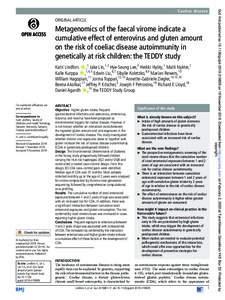Metagenomics of the faecal virome indicate a cumulative effect of enterovirus and gluten amount on the risk of coeliac disease autoimmunity in genetically at risk children: The TEDDY study
Katri Lindfors; Jake Lin; Hye-Seung Lee; Heikki Hyöty; Matti Nykter; Kalle Kurppa; Edwin Liu; Sibylle Koletzko; Marian Rewers; William Hagopian; Jorma Toppari; Annette-Gabriele Ziegler; Beena Akolkar; Jeffrey P Krischer; Joseph F Petrosino; Richard E Lloyd; Daniel Agardh; TEDDY Study Group
https://urn.fi/URN:NBN:fi-fe2021042827356
Tiivistelmä
Objective Higher gluten intake, frequent gastrointestinal infections and adenovirus, enterovirus, rotavirus and reovirus have been proposed as environmental triggers for coeliac disease. However, it is not known whether an interaction exists between the ingested gluten amount and viral exposures in the development of coeliac disease. This study investigated whether distinct viral exposures alone or together with gluten increase the risk of coeliac disease autoimmunity (CDA) in genetically predisposed children.
Design The Environmental Determinants of Diabetes in the Young study prospectively followed children carrying the HLA risk haplotypes DQ2 and/or DQ8 and constructed a nested case–control design. From this design, 83 CDA case–control pairs were identified. Median age of CDA was 31 months. Stool samples collected monthly up to the age of 2 years were analysed for virome composition by Illumina next-generation sequencing followed by comprehensive computational virus profiling.
Results The cumulative number of stool enteroviral exposures between 1 and 2 years of age was associated with an increased risk for CDA. In addition, there was a significant interaction between cumulative stool enteroviral exposures and gluten consumption. The risk conferred by stool enteroviruses was increased in cases reporting higher gluten intake.
Conclusions Frequent exposure to enterovirus between 1 and 2 years of age was associated with increased risk of CDA. The increased risk conferred by the interaction between enteroviruses and higher gluten intake indicate a cumulative effect of these factors in the development of CDA.
Kokoelmat
- Rinnakkaistallenteet [27094]
